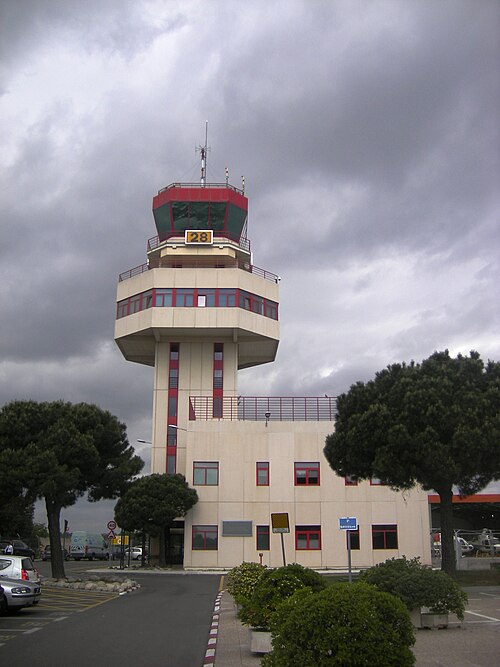Madrid–Cuatro Vientos Airport | |||||||||||||||
|---|---|---|---|---|---|---|---|---|---|---|---|---|---|---|---|
 Cuatro Vientos Airport Control Tower | |||||||||||||||
| Summary | |||||||||||||||
| Airport type | Public/Military | ||||||||||||||
| Operator | AENA | ||||||||||||||
| Location | Madrid | ||||||||||||||
| Hub for | Flylink Express | ||||||||||||||
| Elevation AMSL | 2,269 ft / 691 m | ||||||||||||||
| Coordinates | 40°22′14″N3°47′06″W / 40.37056°N 3.78500°W /40.37056; -3.78500 | ||||||||||||||
 Interactive map of Madrid–Cuatro Vientos Airport | |||||||||||||||
| Runways | |||||||||||||||
| |||||||||||||||
| Statistics (2016) | |||||||||||||||
| |||||||||||||||
| Sources:Aena[1] | |||||||||||||||

Madrid–Cuatro Vientos Airport (ICAO:LECU), also known asCuatro Vientos Airport, is the oldest airport in Spain, established in 1911 (114 years ago) (1911) and one of the three civil airports of Madrid along withMadrid–Barajas andMadrid–Torrejón Airport. The airport is located 8 km (5.0 mi) southwest of the city centre. The name "Cuatro Vientos"[ˈkwatɾoˈβjentos] translates into English as "Four Winds".
Cuatro Vientos was originally an air base, which later became also a civil airport. Thus, there is a military section located on a separate apron of the airport, opposite to the civil one. It is also used as the Madrid base for aircraft of the Spanish Police, as well as for the road traffic surveillance helicopters.
On 31 July 1919, an English aviator James Arthur Peters made the first non-stop flight from the UK to Spain. He flew an Alliance aircraft, a Seabird P1 that he had designed, from Hendon airport to Cuatro Vientos in 9 hours. His navigator was named as Curtiss.He carried a letter for the Queen of Spain from Mr Gillow the owner of the company that made the aircraft.Peters later flew back to the UK and named his house in Kings Langley, Herts. ‘Cuatro Vientos’.
Emilio Herrera Linares created an aerodynamics laboratory.In 1936, he tested there hisstratonautical space suit, a precursor of thespace suit to explore thestratosphere.The start of theSpanish Civil War cancelled the planned balloon trip to test it.[2]
This airport is mainly used bygeneral aviation aircraft, Flight Training Organizations and flying clubs. Due to the runway length and surrounding buildings it is only possible to operate helicopters, piston engine aircraft, medium size turbo-props and small business jets. The only navigational aid is anon-directional beacon.
TheMuseum of Aeronautics and Astronautics, an air and space museum mainly dedicated to the Spanish Air and Space Force, is located on the southern side of the airport.